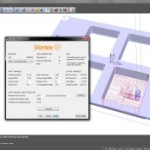FeatureCAM includes Vortex milling calculator

FeatureCAM 2015 R2 includes the Vortex milling calculator to help users obtain the maximum benefit from the high-efficiency area-clearance strategy.
The 2015 R2 release of Delcam’s FeatureCAM feature-based CAM software incorporates a milling calculator to help users obtain the maximum benefit from the Vortex high-efficiency area-clearance strategy.
Other enhancements, among the 280 customer-requested improvements since the initial 2015 release last September, include the ability to create multi-tool blocks within machine designs, better control over toolpath output and more efficient automatic selection of tools.
FeatureCAM was the world’s first feature-based programming software when it was launched in 1995. Constant development since then has ensured that the system has retained its leadership in programming speed and ease of use, while an increased range of strategies has been added to provide more efficient toolpaths that give greater productivity on a wider range of machinery, including mill-turn machines, five-axis mills and wire EDM equipment.
The Vortex area-clearance strategy in FeatureCAM produces safe toolpaths with a much deeper cut by using a controlled engagement angle that maintains the optimum cutting conditions for the whole toolpath. As a result, higher feed rates and material-removal rates are possible, making the cutting time shorter by as much as 70%. In addition, cutting is undertaken at a more consistent volume-removal rate and at a near constant feed rate, so extending tool life and protecting the machine.
The radical nature of Vortex can make it difficult for users to set the optimum parameters when they first apply the strategy. To overcome this problem, Delcam has added a calculator that provides an easy way to maximise productivity and efficiency with Vortex. The calculator uses control of the maximum chip thickness to calculate the appropriate feeds and speeds that will minimise the cutting time while maintaining a consistent load on the cutter.
A new development in the Vortex strategy itself will make it more efficient when machining flat areas or open pockets. In both cases, Vortex now allows the cutter to approach from outside the stock rather than having to make a helical entry move into the stock.
Both Vortex and other two-axis toolpaths have new output options. These give control over point filtering and arc fitting, both of which can contribute to smother machine motion and, therefore, to better surface finish.
In a related development, toolpath points can now be displayed by using the dialog for output options. This allows the user to view the toolpath points and check that their distribution is compatible with the machine-tool controller.
As machines have become more sophisticated, accurate simulation has become increasingly important before toolpaths are passed to the machine. In FeatureCAM 2015 R2, multi-tool blocks can be created within machine-design files. Tool blocks can be developed with a list of tool locations and then the attributes can be specified describing the type of tool to be held in each location. The blocks can then be used in the simulation of the movement of the part being machined towards the various tools.
The programming time for drilling has been reduced significantly in the new release. Specific pecking depths can now be allocated to drills on a tool by tool basis. This change means that there is no longer any need to update the global pecking defaults after the creation of features needing to be drilled.
In addition, the exposed length of all tools is now checked as part of automatic tool selection. The check allows tools to be verified against the depth of the feature or the set-up depth so that potential collisions can be avoided.



